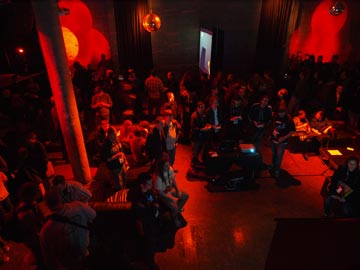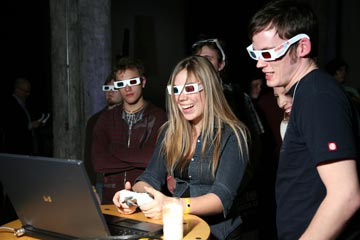Trying to explain GAMMA is kind of like trying to describe Burning Man. The members of Kokoromi Collective best described their annual showcase for game creation and art as a “curated live game event organized in a party-like atmosphere complete with music, DJs, and VJs.”
It all began because of a request for an interactive game by the Society for Arts and Technology (SAT) for their event at Nuit Blanche (both events mentioned in my post, Augmenting Reality: Paul Warne). Game designer Heather Kelley took her hit game experiment Lapis (an innocent game for Nintendo DS console modeled on patterns of female orgasm, which won the sex-themed 2005 Game Design Challenge in Montreal) and adapted it for local artist Luc Courchesne’s Panoscope (a semi-sphere projector that becomes an immersive environment) with the help of fellow game designer Phil Fish and programmer Damien Di Fede.
Lapin d’hiver from Heather Kelley on Vimeo.
The infectious enthusiasm of first-time game-players teaching others how to play Lapis inspired Kelley and Fish to recreate this energy. And thus GAMMA was born. Game designers Kelley, Fish, and Di Fede were joined by digital media creator and curator Cindy Poremba to form The Kokoromi Collective. The collective has devoted itself to promoting video games as an art form and expressive medium. In 2009, the collective was featured in the BNL MTL (Montreal’s biennial spearheaded by the Centre International d’Art Contemporain de Montreal).
With GAMMA, Kokoromi intends to either anticipate or subvert upcoming trends by challenging innovation from participating contributors. They hope to stimulate experimentation (‘Kokoromi’ itself means experiments in Japanese) and, in fact, develop the codes for people to use so that programmers can focus on the actual structure and experience of the game itself.
Their first year (2006) featured games requiring audio feed (i.e. live music); thus a DJ’s output became the input for the game play. Without sound, the game would not function. The codes (aka processing library) they compiled for this inaugural year are now widely used today for audio-input games.
For GAMMA 256 in 2007, Kokoromi went against the grain of the mounting appeal of high resolution (HD, Xbox 360) and set a 256 x 256 parameter for pixel resolution of its games and encouraged a non-standard aspect ratios. The five-minute-long game Passage, from Jason Rohrer, became a hit after GAMMA. It compressed an entire lifetime into the time frame of the experience of proceeding rightward through the game, collecting points and proceeding through life. Unlike age-old video games, death in Passage is final. The lived experience of the player/viewer incites reflection about mortality and about the nature of games themselves.
2008’s GAMMA 3D, far before Avatar and today’s 3D craze, aimed to explore whether a game could be designed using red-blue stereoscopy and rely completely on depth perception to experience a game. Kokoromi produced a game, using head tracking, called Super HYPERCUBE, a sort of 3D Tetris where the goal is to fit a complex shape through the hole on a free-floating wall (sort of like the human Tetris on Japanese game shows). The experience brought the video game world further into reality, engaging with spatiality and positioning.
Finally, in the last rendition, called GAMMA4, the Collective featured their event at the Game Developer’s Conference in San Francisco in early 2010, soliciting submissions for one-button games. While they toyed with the idea of Augmented Reality as their theme, the Collective felt that there were still interesting things to do with simple one-button on-off switches. Gamma 4 was accompanied with a show at the Gray Area Foundation for the Arts, curated by Kelley and Peter Kirn (founder of Create Digital Motion), which featured unique one-button interface objects. Among the displayed works was a life-size heart created by artist Lauren Gardner, consisting of a crocheted heart sock covering an electronic device that, when held, started beating.

The Kokoromi Collective, "GAMMA4 at San Francisco's Mezzanine," documenting photo, 2010. Courtesy of Game Developer's Conference staff photographer.
Poremba, who has been curating alternative art in alternative art spaces for the last five years, always considered interactivity a challenge to the art world, yet praises GAMMA for its capability to get all sorts of people involved, from gamers to art-enthusiasts, from musicians to just plain ol’ regular folk.
But are games art? “Gaming is an entire means of communication. How could it not be art?” Kelley responds incredulously (however not as incredulously as Fish, for whom games are the ultimate art). The live performance and interactive aspects of games are definitely unique. The Sydney Morning Herald, in April of this year, featured an article exploring video games as a genre of creative expression, calling it a new aesthetic medium. Randy Smith, of British computer and video game magazine Edge, proffered video games as a “new space for interactive art.”
What makes games singular is the fact that the immersive experience, while designed, changes according to the participation of the viewer. Video games are thus akin to interactive art and its need for the viewer to exist. The participant (no longer simply a viewer) authors the experience. The question ‘can games be art?’ thus becomes transformed: Can art be active? Can art place so much authorial power with the viewer?
As the debate continues, Kokoromi forges ahead supporting experimental games as a form of expression and the game play experience as a form of art. And Montreal seems to be an appropriate home for the collective. With its resources of great local know-how (a byproduct of the animation, computer, and game design industries in Montreal) and a nurtured interest in experimental art and technology (one needs only to look to the SAT), Montreal seems to rejoice in the curated environment of GAMMA. Play on!





Pingback: Game (as) Art: The Kokoromi Collective by Stefan Zebrowski-Rubin | jacques urbanska veille et blog